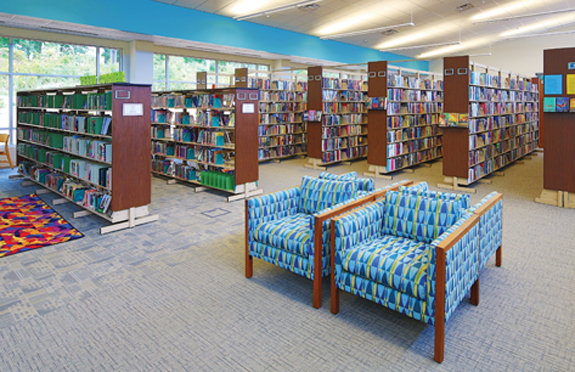Powerful Floors | Library by Design, Spring 2016

Keeping up with the ever-growing demand for network connectivity and power is every library leader’s challenge. Solutions exist to make cables and power supply accessible; the trouble comes when faced with cost, sustainability, stakeholder buy-in, time, and impact on the library environment.
Michael Roche, director of Rockingham County Public Library, NC, dealt with these hurdles and ended up with a successful and popular community space for one of his branches, the Madison-Mayodan Library. He had an idea early on about how he was going to organize cables and bring flexibility to the large space: access flooring. Roche had learned about low-profile access flooring while teaching a course in a Georgia school system years earlier.
“I saw that the floor was slim: only two and a half inches high,” recalls Roche. “The floor panels came up and were easily moved about as the need arose. I found an article on access floors that said you could even use them in arena-sized spaces. I thought, ‘If I ever get the chance, I’m going to do this in my library.’ ”
Roche’s chance came when city leaders of Madison and Mayodan joined forces to create a new shared branch under Roche’s leadership. A 12,300 square foot space would be renovated for the project. As planning began, Roche introduced the flooring company that he had researched and chosen—the author’s Charlotte, NC–based Netfloor USA—to the project’s architect, LS3P Associates, and engineer to work together installing the flooring.
The up-front cost of the access floor was comparable to other types of flooring and would save money over time since it facilitated future wiring and cable changes. When Roche ran the idea past the stakeholders, they agreed unanimously to move forward with access flooring.
“The only challenge is that it increases floor height by two and a half inches,” says Roche.
The Madison-Mayodan Library had ten-foot ceilings on the low end and those angling up to 24 feet in other places. With an additional two and a half inches, the lowest ceiling would be 9'9.5" high.
However, Roche ended up having the ability to install the floors during the construction process, giving the library the opportunity to build a sunken floor to accommodate the access flooring. The resulting floors were flush with entryways and no vertical space was lost. For libraries that don’t have the option of sinking a floor, ramps are used in entryways to transition.
A video of the Madison-Mayodan floor installation is viewable online.
Alternatives to access flooring
The methods for organizing cables include concrete trenching, floor decking, and overhead cable drops.
Concrete trenching involves a construction crew bringing in large machines to dig trenches into the concrete floor. The cables will be run in the floor trenches to provide power sources at designated locations around the room. There are a few issues one can run into with this technique. More trenches must be dug each time a cable needs to be moved. Digging in concrete creates a lot of debris, it is very loud, and it takes weeks to do. The library would be forced to close during the process, unless it’s completed during initial construction.
Still another method of cable management, floor decking, involves cables being run within the ceiling of the level below the floor in question. The cable system hangs from support bars attached to the cement floor or steel decking. Access to the cables is then cut into the floor above. The process is again noisy and requires work on two floors at a time, putting both off-limits until the project is completed. Also, as with trenching, changing the location of power access is a major undertaking. If the library wants to move a power source, technicians must be brought in to reroute the cables from the ceiling and more access holes would need to be cut.
The third alternative to access flooring is overhead cable drops. Cable drops involve running cables through the ceiling and dropping them down through support columns that are built for the purpose of allowing access to the cables. The columns are permanently fixed and in most cases many would need to be added to the space to satisfy the needs of library patrons.
As for the dual North Carolina branch that had the opportunity to install its flooring from the ground up, “We can now offer our patrons everything from video conferencing to online classes...and anything the community needs,” says Roche. “I would go so far as to say [the flooring design] has raised the value of the community as a whole.”
Add Comment :-
RELATED
ALREADY A SUBSCRIBER? LOG IN
We are currently offering this content for free. Sign up now to activate your personal profile, where you can save articles for future viewing








